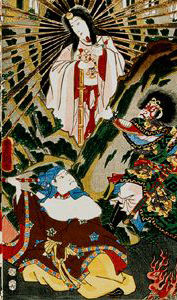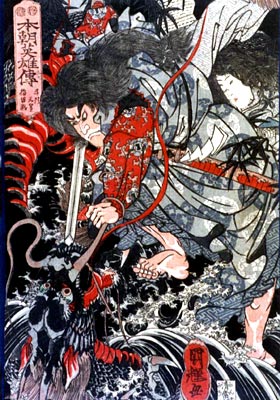| Part of a series on |
| Shinto |
|---|
| Practices and beliefs |
| Shinto shrines |
|
| Notable Kami |
| Important literature |
| Kojiki
|
| See also |
|
Kojiki (古事記, "Record of Ancient Matters") is the oldest extant chronicle in Japan, dating from the early 8th century (711-712) and composed by Ō no Yasumaro at the request of Empress Gemmei.[1] The Kojiki is a collection of myths concerning the origin of the four home islands of Japan, and the Kami. Along with the Nihon Shoki, the myths contained in the Kojiki are part of the inspiration behind Shinto practices and myths, including the misogi purification ritual.[2][3][4][5]
Structure
The Kojiki contains various songs/poems. While the historical records and myths are written in a form of Chinese with a heavy mixture of Japanese elements, the songs are written with Chinese characters that are only used to convey sounds. This special use of Chinese characters is called Man'yōgana, a knowledge of which is critical to understanding these songs, which are written in Old Japanese.
Sections
The Kojiki is divided into three parts: the Kamitsumaki (上巻 "first volume"), the Nakatsumaki (中巻, "middle volume") and the Shimotsumaki (下巻, "lower volume").
- The Kamitsumaki, also known as the Kamiyo no Maki (神代巻, "Volume of the Age of the Gods"), includes the preface of the Kojiki, and is focused on the deities of creation and the births of various deities of the kamiyo period, or Age of the Gods. The Kamitsumaki also outlines the myths concerning the foundation of Japan. It describes how Ninigi-no-Mikoto, grandson of Amaterasu and great-grandfather of Emperor Jimmu, descended from heaven to Takachihonomine in Kyūshū and became the progenitor of the Japanese imperial line. [3][5][6]
- The Nakatsumaki begins with the story of Emperor Jimmu, the first Emperor, and his conquest of Japan, and ends with the 15th Emperor, Emperor Ōjin. The second through ninth emperors' reigns are recorded in a minimum of detail, with only their names, the names of their various descendants, and the place-names of their palaces and tombs listed, and no mention of their achievements. Many of the stories in this volume are mythological, and the allegedly historical information in them is highly suspect. Recent studies support the view that these emperors were invented to push Jimmu's reign further back to the year 660 BC.
- The Shimotsumaki covers the 16th to 33rd emperors and, unlike previous volumes, has very limited references to the interactions with deities. These interactions are very prominent in the first and second volumes. Information about the 24th to the 33rd emperors are largely missing, as well.
Study of the Kojiki
In the Edo period, Motoori Norinaga studied the Kojiki intensively. He produced a 44-volume study of the Kojiki called Kojiki-den (古事記伝, "Kojiki commentary").
The first and best-known English translation of the Kojiki was made by the renowned Japanologist Basil Hall Chamberlain. More recently, a translation by Donald L. Philippi was published by University of Tokyo Press in 1968 (ISBN 0-86008-320-9).
Manuscripts
There are two major branches of Kojiki manuscripts: Ise and Urabe. The extant Urabe branch consists of 36 existing manuscripts all based on the 1522 copies by Urabe Kanenaga. The Ise branch may be subdivided into the Shinpukuji-bon (真福寺本) manuscript of 1371-1372 and the Dōka-bon (道果本) manuscripts. The Dōka sub-branch consists of:
- the Dōka-bon (道果本) manuscript of 1381; only the first half of the first volume remains
- the Dōshō-bon (道祥本) manuscript of 1424; only the first volume remains, and there are many defects
- the Shun'yu-bon (春瑜本) manuscript of 1426; one volume
The Shinpukuji-bon manuscript (1371–1372) is the oldest existing manuscript. While divided into the Ise branch, it is actually a mixture of the two branches. The monk Ken'yu based his copy on Ōnakatomi Sadayo's copy. In 1266, Sadayo copied volumes one and three, but did not have access to the second volume. Finally, in 1282, he obtained access to the second volume through a Urabe-branch manuscript that he used to transcribe.
See also
- Historiographical Institute of the University of Tokyo
- International Research Center for Japanese Studies
- Japanese Historical Text Initiative
- Historiography of Japan
- Atsuta Shrine
- The White Hare of Inaba
- Kokki
- Kujiki
- Kyūji
- Mahoroba
- Nihon Shoki
- Philosophy of History
- Teiki
- Tennōki
Notes
- ^ Habersetzer, Gabrielle & Roland (2004). Encyclopédie technique, historique, biographique et culturelle des arts martiaux de l'Extrême-Orient. Amphora. p. 380. ISBN 2-85180-660-2.
- ^ Reader, Ian (2008). Simple Guides: Shinto. Kuperard. p. 33,60. ISBN 1-85733-433-7.
- ^ a b "Kojiki". Encyclopedia of Japan. Tokyo: Shogakukan. 2012. OCLC 56431036. Retrieved 2012-09-18.
- ^ "古事記" [Kojiki]. Dijitaru Daijisen (in Japanese). Tokyo: Shogakukan. 2012. OCLC 56431036. Retrieved 2012-09-18.
- ^ a b "古事記" [Kojiki]. Nihon Kokugo Daijiten (in Japanese). Tokyo: Shogakukan. 2012. OCLC 56431036. Retrieved 2012-09-18.
- ^ "Ninigi no Mikoto". Encyclopedia of Japan. Tokyo: Shogakukan. 2012. OCLC 56431036. Retrieved 2012-09-18.
References
- Bently, John R. The Authenticity of Sendai Kuji Hongi: A New Examination of Texts, With a Translation And Commentary. ISBN 90-04-15225-3
- Brownlee, John S. (1997) Japanese historians and the national myths, 1600-1945: The Age of the Gods and Emperor Jimmu. Vancouver: University of British Columbia Press. ISBN 0-7748-0644-3 Tokyo: University of Tokyo Press. ISBN 4-13-027031-1
- Brownlee, John S. (1991). Political Thought in Japanese Historical Writing: From Kojiki (712) to Tokushi Yoron (1712). Waterloo, Ontario: Wilfrid Laurier University Press. ISBN 0-88920-997-9
- Chamberlain, Basil Hall. (1919). The Kojiki.
- Nihon Koten Bungaku Daijiten Henshū Iinkai (1986). Nihon Koten Bungaku Daijiten (in Japanese). Iwanami Shoten. ISBN 4-00-080067-1.
- Ono, Motonori Shinto: The Kami Way
- Philippi, Donald L. Philippi. (1968) Kojiki. Tokyo: University of Tokyo Press. 10-ISBN 0-86008-320-9
- Starrs, Roy (2005). "The Kojiki as Japan's National Narrative", in Asian Futures, Asian Traditions, edited by Edwina Palmer. Folkestone, Kent: Global Oriental, ISBN 1-901903-16-8
- Yamaguchi, Yoshinori; Takamitsu Kōnoshi (1997). Nihon Koten Bungaku Zenshū: Kojiki. Tōkyō: Shogakukan. ISBN 4-09-658001-5.
External links
- (English) The Internet Sacred Text Archive: Chamberlain's translation of Kojiki.
- (English) Encyclopedia of Shinto Kokugakuin University
- (English) Basic Terms of Shinto Kokugakuin University
- (Japanese) Online original text of Kojiki and other texts
- (Japanese) Waseda University Library: 1644 manuscript, three volumes
| |||||||||||||||||||||||||||||||||||

